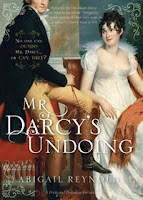In England during the Regency Era, there were no funeral parlors or funeral homes. When a person died, the body remained at home. Sometimes an undertaker came prepare the body and sometimes a family member or a servant such as a valet usually did it. Most often, though, women were expected to perform that duty. (Odd that, since women weren't generally allowed to attend the funeral lest their delicate constitutions be too strained.) Anyway, whomever had this unpleasant task washed the hair and body also dressed the body. They often used props to arrange the body's position, such as under the chin to keep the mouth closed.
Bodies were usually laid out on a table for mourners to come pay their respects. The bodies were encased in a shroud, even in the coffin, which was usually made of wool or cambric unless the family were willing to pay for silk. A law was passed in the 18th century that shrouds had to be wool, unless people paid for the privilege of having something else. This act was passed to protect the wool trade. I could comment on that, but I won't. :-)
They didn't embalm in those days. Though America began embalming as early as the Civil War, (well after the Regency Era) that practice didn't take off in England for many years. To help with preservation, bodies were sometimes laid on ice. As you can imagine, that created problems with melting ice and disposing of the water. Usually, burials happened within a week since bodily decay happened quickly and depended on many factors beyond just climate. Obese bodies decay faster than thin ones. Alcoholics, contrary to popular belief, do not get "pickled" but instead decay faster. This is the same for those who suffered from long-term disease.
 |
| Queen Victoria and her beloved Prince Albert |
The rich were buried in family tombs or inside churches. The middle class were buried in the ground in coffins. The very poor were thrown into common graves. I also read that poor people sometimes rented a coffin to get the body to the graveyard and then tipped it until the body slid out and into the grave. The leased coffin was then returned to the coffin maker. That conjures up all kinds of images, doesn't it?
They didn't use "caskets," they used "coffins," which had a widened area for the shoulders like what we think of for Dracula's coffin. Coffins were fresh-cut from pine after a person's death, so that the strong pine smell could help with body odors. Hmmm, maybe they should have strewn pine chips or cedar chips around Prince Albert's body in addition to the lilies :-)
A person who committed the heinous crime of suicide, also know as self-murder, was buried vertically at a cross roads, supposedly to keep the spirit from knowing which way to travel. Why, vertically, I don't know.
If you want more information, I recommend "The Victorian Undertaker" by Trevor May, a thin volume that you can read in about an hour. Although it discusses the Victorian Era, there isn't much about death and burial had changed from the Regency Era.
This concludes your trip into the macabre.
Oh, and Happy Halloween. Mwahahaha.















